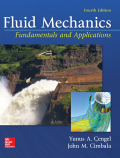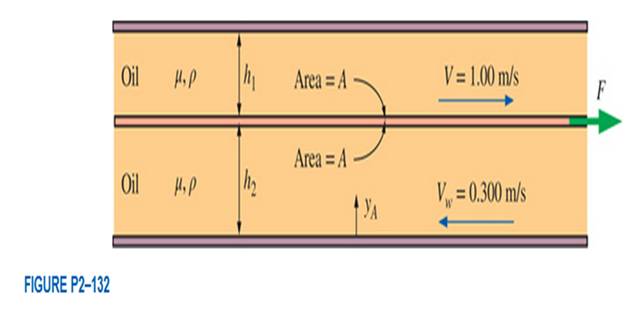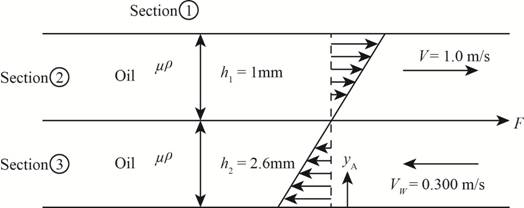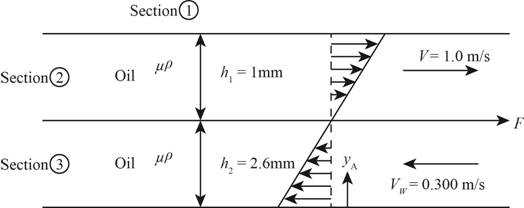
Concept explainers
Oil of viscosity
The top plate is stationary, but the bottom plate is moving at velocity

(a)
Velocity profiles between the plates and the distance where velocity is zero.
Answer to Problem 132P
The below figure shows the velocity profile.

The velocity is zero from bottom at the height of
Explanation of Solution
Given information:
Dynamic viscosity is
The velocities will be zero at the boundaries of the plate due to no slip condition.
Write the expression for the velocity.
Here, the pressure gradient is
Calculation:
Substitute
The below figure shows the velocity profile.

Figure-(1)
Conclusion:
The velocity is zero from bottom at the height of
(b)
The force required for moving the middle plate at constant speed.
Answer to Problem 132P
The force required for moving the middle plate at constant speed is
Explanation of Solution
Write the expression for the force required.
Here, shear stress is
Write the expression for the shear stress.
Here, shear stress is
Substitute
Write the expression for the force required between first and second plate.
Here, velocity gradient between plate one and two is
Write the expression for the force required between the second and third plate.
Here, velocity gradient between plate two and three is
Write the expression for the total force.
Here, total force is
Write the expression for velocity gradient between plate one and two.
Here, steady velocity of plate two is
Write the expression for velocity gradient between plate two and three.
Here, steady velocity of plate two is
Substitute
Calculation:
Substitute
Conclusion:
The force required for moving the middle plate at constant speed is
Want to see more full solutions like this?
Chapter 2 Solutions
EBK FLUID MECHANICS: FUNDAMENTALS AND A
- Q.1) Block A is connected to block B by a pulley system as shown. The weights of blocks A and B are 100 lbs and 70 lbs, respectively. Assume negligible friction between the rope and all pulleys as well as between block B and the incline and neglect the mass of all pulleys and cables. Determine the angle 0 required to keep the system in equilibrium. (At least two FBDs must be drawn for full credit) B Ꮎ 000arrow_forwardpls solvearrow_forward+1. 0,63 fin r= 0.051 P The stepped rod in sketch is subjected to a tensile force that varies between 4000 and 7000 lb. The rod has a machined surface finish everywhere except the shoulder area, where a grinding operation has been performed to improve the fatigue resistance of the rod. Using a 99% probability of survival, determine the safety factor for infinite life if the rod is made of AISI 1080 steel, quenched and tempered at 800°c Use the Goodman line. Does the part fail at the fillet? Explainarrow_forward
- Solve this problem and show alll of the workarrow_forwardI need drawing solution,draw each one by one no Aiarrow_forwardQu. 17 Compute linear density values for [100] for silver (Ag). Express your answer in nm''. . Round off the answer to three significant figures. Qu. 18 Compute linear density value for [111] direction for silver (Ag). Express your answer in nm'. Round off the answer to three significant figures. Qu. 19 Compute planar density value for (100) plane for chromium (Cr). Express your answer in nm?. Round off the answer to two significant figures. Qu. 20 Compute planar density value for (110) plane for chromium (Cr). Express your answer in nm ≥ to four significant figures. show all work please in material engineeringarrow_forward
 Elements Of ElectromagneticsMechanical EngineeringISBN:9780190698614Author:Sadiku, Matthew N. O.Publisher:Oxford University Press
Elements Of ElectromagneticsMechanical EngineeringISBN:9780190698614Author:Sadiku, Matthew N. O.Publisher:Oxford University Press Mechanics of Materials (10th Edition)Mechanical EngineeringISBN:9780134319650Author:Russell C. HibbelerPublisher:PEARSON
Mechanics of Materials (10th Edition)Mechanical EngineeringISBN:9780134319650Author:Russell C. HibbelerPublisher:PEARSON Thermodynamics: An Engineering ApproachMechanical EngineeringISBN:9781259822674Author:Yunus A. Cengel Dr., Michael A. BolesPublisher:McGraw-Hill Education
Thermodynamics: An Engineering ApproachMechanical EngineeringISBN:9781259822674Author:Yunus A. Cengel Dr., Michael A. BolesPublisher:McGraw-Hill Education Control Systems EngineeringMechanical EngineeringISBN:9781118170519Author:Norman S. NisePublisher:WILEY
Control Systems EngineeringMechanical EngineeringISBN:9781118170519Author:Norman S. NisePublisher:WILEY Mechanics of Materials (MindTap Course List)Mechanical EngineeringISBN:9781337093347Author:Barry J. Goodno, James M. GerePublisher:Cengage Learning
Mechanics of Materials (MindTap Course List)Mechanical EngineeringISBN:9781337093347Author:Barry J. Goodno, James M. GerePublisher:Cengage Learning Engineering Mechanics: StaticsMechanical EngineeringISBN:9781118807330Author:James L. Meriam, L. G. Kraige, J. N. BoltonPublisher:WILEY
Engineering Mechanics: StaticsMechanical EngineeringISBN:9781118807330Author:James L. Meriam, L. G. Kraige, J. N. BoltonPublisher:WILEY





